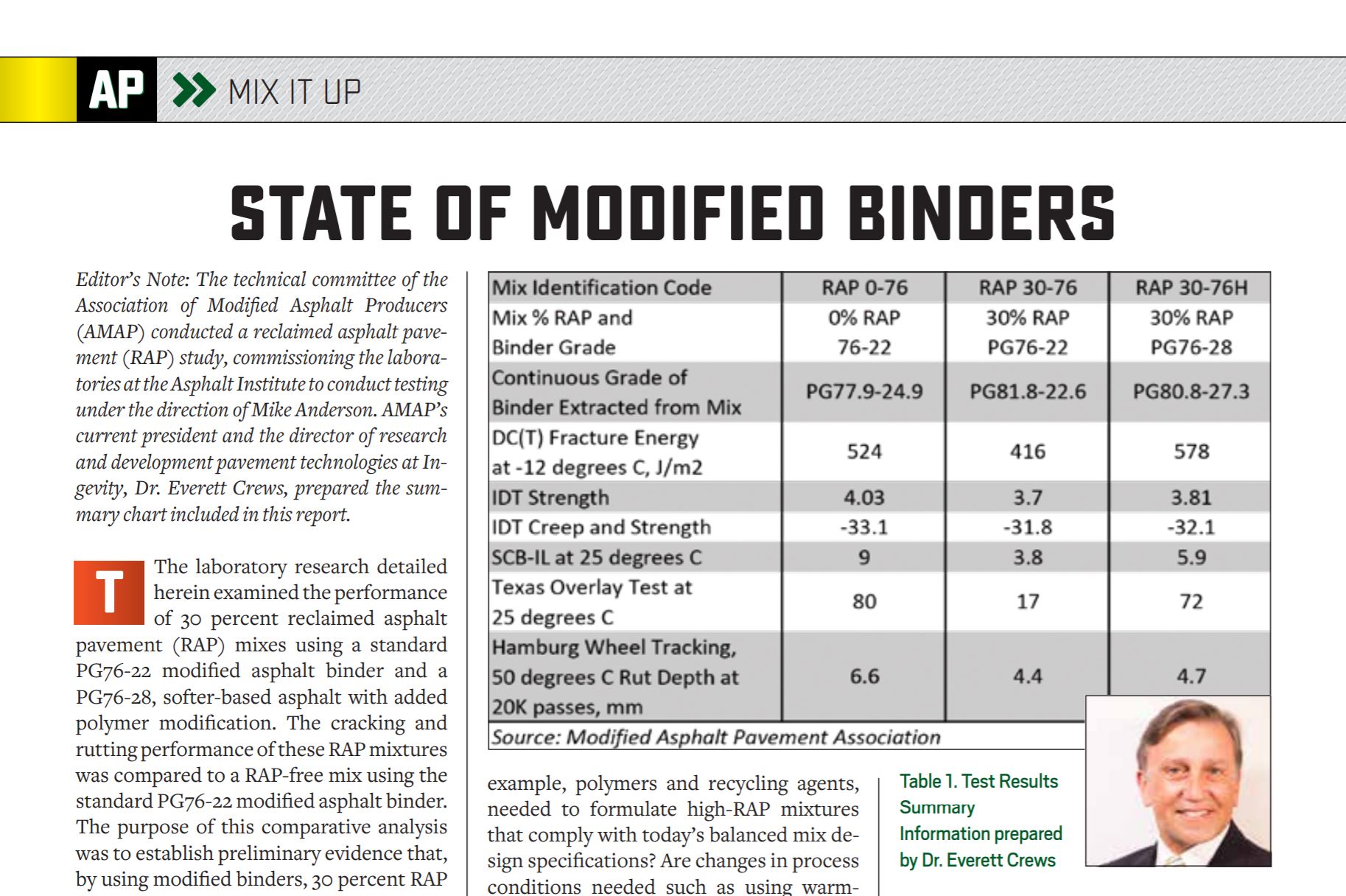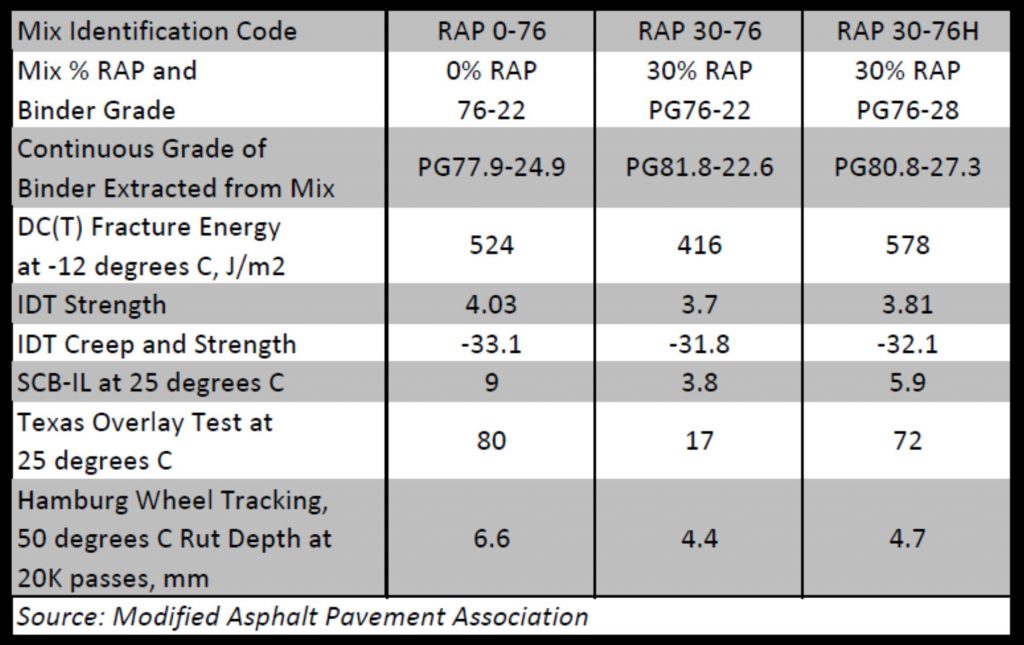AMAP RAP Study Results
BY Skip Paul

Editor’s Note: The technical committee of the Association of Modified Asphalt Producers (AMAP) conducted a reclaimed asphalt pavement (RAP) study, commissioning the laboratories at the Asphalt Institute to conduct testing under the direction of Mike Anderson. AMAP’s current president and the director of research and development pavement technologies at Ingevity, Dr. Everett Crews, prepared the summary chart included in this report.
The laboratory research detailed herein examined the performance of 30 percent reclaimed asphalt pavement (RAP) mixes using a standard PG76-22 modified asphalt binder and a PG76-28, softer-based asphalt with added polymer modification. The cracking and rutting performance of these RAP mixtures was compared to a RAP-free mix using the standard PG76-22 modified asphalt binder. The purpose of this comparative analysis was to establish preliminary evidence that, by using modified binders, 30 percent RAP mixtures could be designed to equal or exceed the performance of RAP-free mixtures for either wearing courses or intermediate pavement layers.
As our global paving industry pursues the sustainability objective of 100 percent asphalt pavement recycling, it becomes increasing clear that asphalt modifiers such as polymers, phosphate additives, recycling agents, warm-mix additives and many others, will have a prominent part in achieving this goal.
Best Practices for Crushing, Screening RAP for HMA Production
In this study, it showed that a 30 percent RAP mixture using a highly-modified PG76-28 binder could be a cost-effective substitute for a RAP-free mixture using a PG76-22 binder in wearing course applications. The results also suggest, however, there may be cost/performance limits to the benefits that modifiers may impart. How much polymer is needed to overcome the impact of RAP binder on low-temperature fracture? Does an increase in RAP in surface mixtures warrant the cost increase resulting from increased polymer, recycling agent or warm-mix additive contents? Are packaged products, which combine, for example, polymers and recycling agents, needed to formulate high-RAP mixtures that comply with today’s balanced mix design specifications? Are changes in process conditions needed such as using warm-mix production temperature or marinating RAP to achieve higher RAP contents? Or, would a greater use of RAP in bases, intermediate layers, shoulders, and low-volume roads be a more cost-effective and sustainable approach versus 100 percent recycling? Future AMAP research intends to address these types of questions, but here’s what we’ve discovered in the current study.
Background on the Materials and Mixtures in the AMAP RAP Study
Two different binder grades (a PG76-22 and a PG76-28) were used in the laboratory study to prepare three different limestone mixtures at hot-mix temperatures. Two mixtures were prepared with a PG76-22 using 0 and 30 percent RAP. The third mixture was prepared using a PG76-28 binder with 30 percent RAP.
The gradations of the aggregate were carefully batched so that each mixture contained the same aggregate skeleton. Triplicate analyses of the extracted RAP binder showed that the binder content was 5.27 percent ± 0.09 percent, and the average continuous PG grade of the RAP was PG89.3-18.1. The two virgin polymer-modified binders used in the mixtures had continuous grades of PG77.9-24.9 and PG76.1-32.1.
AMAP RAP Study Results and Discussion

Table 1. Test Results Summary
Information prepared by Dr. Everett Crews
The table summarizes the salient results of the study. All performance tests, except Hamburg and IDT Creep Strength, were conducted in triplicate. Read summary highlights of results on the AMAP website.
The salient findings of this study include the following:
- At -12°C test temperature, the DC(T) test showed higher average fracture energy for the RAP30-76H mixture followed by the RAP30-76H mixture. A larger set of replicate test specimens is needed in DC(T) and other fracture tests because of their inherent high experimental error. Nevertheless, the RAP30-76H could substitute in wearing courses for the RAP0-76. Similarly, the RAP30-76 would perform very well in intermediate layers.
- The difference in the critical cracking temperatures of the three mixtures as determined using IDT creep and strength testing was similarly obscured by the high experimental error of the test.
- For the intermediate cracking tests at 25°C (Texas Overlay and SCB-IL), the average results show that the mix with no RAP (designated as RAP0-76) looked the best. The mix with 30 percent RAP and the specially formulated PG76H-28 asphalt binder (designated as RAP30-76H) looked next best—better than the 30 percent RAP mix with just the PG76-22 (designated as RAP30-76). In the case of the SCB-IL Flexibility Index, the RAP30-76H was statistically equal to the control mix (RAP0-76), indicating that 30 percent RAP is viable in this limestone mixture for surface courses. Both the RAP0-76 and RAP30-76H were statistically different (i.e., better for Flexibility Index) than the RAP30-76 mix.
- The variability in cycles to failure in the Texas Overlay Test made it difficult to identify any statistically significant differences among the three mixes (although the same trend in the average results is seen as was seen in the SCB-IL test). However, the data shows that the RAP30-76H mixture could be used by contractors as successfully as the RAP-free PG76-22 mixture.
- All mixtures passed the Hamburg Wheel Tracking test. The RAP0-76 mix showed slightly higher average rut depth than either the RAP30-76 or the RAP30-76H mixes.
In summary, the use of a specially formulated PG76H-28 asphalt binder in the 30 percent RAP mix appears to result in equal or improved performance compared to the same 30 percent RAP mix with a PG76-22 asphalt binder. Surface mixtures with the RAP30-76H would be expected to perform equally to the RAP-free mixture. The RAP30-76 mixture would be expected to perform very well in intermediate pavement layers. A copy of the AMAP RAP report can be found on AMAP’s website www.modifiedasphalt.org.

Skip Paul
Skip Paul is the chairman of the AMAP State DOT Advisory Board. This article, which he presented at the AASHTO COMP meeting, appears courtesy of AMAP, which holds its next conference and workshop in Rancho Mirage, California, Feb. 10-13, 2020.
